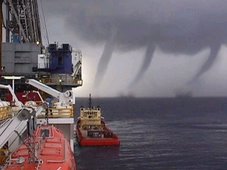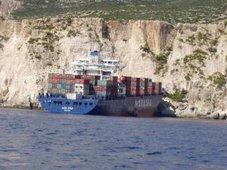 National Weather Service in Norman gauges readiness
National Weather Service in Norman gauges readinessNORMAN — There were no black clouds rolling in from the southwest. No lightning strikes. No hail denting car hoods.
So why were all the emergency management vehicles in the parking lot of the National Weather Center on Tuesday?
Because more than 100 emergency managers, media, National Weather Service and other National Oceanic and Atmospheric Administration personnel are preparing for the days the clouds, the lightning, the hail and possibly much more bully their way into Oklahoma.
Tuesday marked the opening day of the National Weather Service’s three-day "Next Generation Warning Services Workshop.”
"The idea is to make our warning services for hazardous weather better,” said Kevin Scharfenberg, the weather service’s severe storm services coordinator.
Tom Merrill is the Emergency Manager for Cordell in Washita County. He said the weather service is receptive to making changes to fit the needs of the end-users — emergency management and the citizens they protect.
Merrill said in January the Weather Service starts going to communities to train storm spotters. In March, a severe weather workshop is held.
"That prepares everyone for the storm season,” he said. "Plus, it’s great to be sitting in Cordell talking on a ham radio during severe weather and know who you are talking to at the National Weather Service. You have a feel for what he’s wanting.”
He praised the OK
FIRST program through the Oklahoma Climatological Survey that prepares personnel for severe weather.
Lloyd Colston also is attending this week’s "Next Generation Warning Services Workshop.” Colston is the director of emergency management for the city of Altus in Jackson County.
"We live in an age when the sirens are not enough,” Colston said.
In the last two months, Colston has set up AltusEm.Blogspot.com and Twitter.com/AltusEm.
WEATHER NOTERogue wave drowns 3 people
2 others survive Mugu Rock waters
Three young Oxnard men died Thursday after being swept off a rocky ledge and into the ocean near Point Mugu.
Shortly before 2 p.m., a wave knocked five people into the water beneath Mugu Rock, according to witnesses. The two survivors, a 17-year-old and a 27-year-old, made it to the shore and started calling for help, said Ventura County Sheriff's Sgt. Steve Sagely.
Three others were later pulled out of the water. All three were pronounced dead at the scene, Sagely said. On Friday, the Ventura County Medical Examiner's Office identified two of the dead as brothers, Catalino Ramos Vasquez, 19, and Marcelo Ramos Vasquez, 17. The other victim was identified as Pedro Avila Ramos. His age was not immediately known.
A woman at the popular ocean lookout responded to the calls for help before rescue crews arrived, jumping into the water and pulling one of the three victims onto shore, according to witnesses.
Sagely identified her as 24-year-old Kathryn Barrona of Camarillo. He called her actions heroic. She could not be reached for comment.
The two other men were pulled from the water by emergency responders, including rescue swimmers and a helicopter crew, by 2:30 p.m.
The victims' names were not released, pending notification of family members. It was unclear if they all were related.
Ana Savedra of Canyon Country was reading in her car parked on the turnout at Mugu Rock and watched as the five headed down the rocky hill closer to the water.
"They seemed like they were having fun," she said. Later, however, Savedra saw people running around, calling for help. Rescue crews and a helicopter came quickly, she said.
Previous drownings have been reported in the same area, including a 16-year-old boy who was swept into the water while fishing off a cliff below Mugu Rock in January.
For the past two years, Savedra has been going to the same spot to relax.
"It's a beautiful place," she said, but she's never gone down the hill where the tide crashes up against the rocky shoreline. "It's very dangerous."
Russian Register of Shipping - Guarantee for quality and safety
Russian Maritime Register of Shipping (RS) has been awarded a golden medal ‘Guarantee for quality and safety’. RS has become a laureate of National Safety awards and has received a golden medal in the nomination “For the development of technical standards aimed at ensuring safety of offshore oil and gas facilities”. The National Safety awards were held during the “Russian Industrial Exhibition – 2008”. More than 300 Russian and foreign companies participated in the event.
As a participant RS has submitted its Rules for the Classification, Construction and Equipment of Mobile Offshore Drilling Units (MODU) and Fixed Offshore Platforms (FOP). The Rules are based on the scientific research carried out by the leading scientific organizations of Russia (in total over 40 research works).
The Rules are systematically being improved and in the 2008 the third edition was published. The new edition is based upon the IMO and IACS recommendations and the latest research results as regards the advanced study of the external loads on the FOP hull structure, incorporating the requirements to the TLP and Spar installations in the Rules, further improvement of the formal safety assessment of MODU and FOP, continuous monitoring of the FOP subject to the heavy ice loads.
RS allocates considerable resources to perform scientific research aimed at enhancing safety and environment protection standards.
The requirements of the RS rules aimed at minimising the mankind impact on the marine environment are based upon scientifically based risk assessment and risk management procedures.
Source: Russian Maritime Register of Shipping
Mich. law restricting ballast dumping is upheld
A federal appeals court has upheld a Michigan law designed to prevent oceangoing freight ships from bringing invasive species to the Great Lakes.
The 6th U.S. Circuit Court of Appeals on Friday rejected a challenge to the law filed by shipping organizations.
The 2005 law requires saltwater ships calling at Michigan ports to get a permit from the state Department of Environmental Quality.
The permit certifies that the ship will not discharge ballast water in port or has technology to kill any live organisms in the water before it's dumped.
More than 180 invasive species are in the Great Lakes. Many of them are believed to have arrived in ship ballast.
RS


































































































![Validate my RSS feed [Valid RSS]](valid-rss.png)